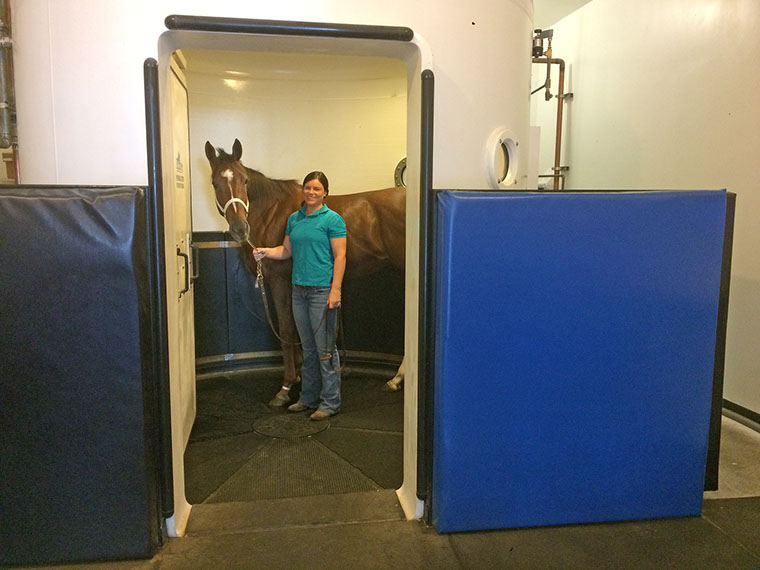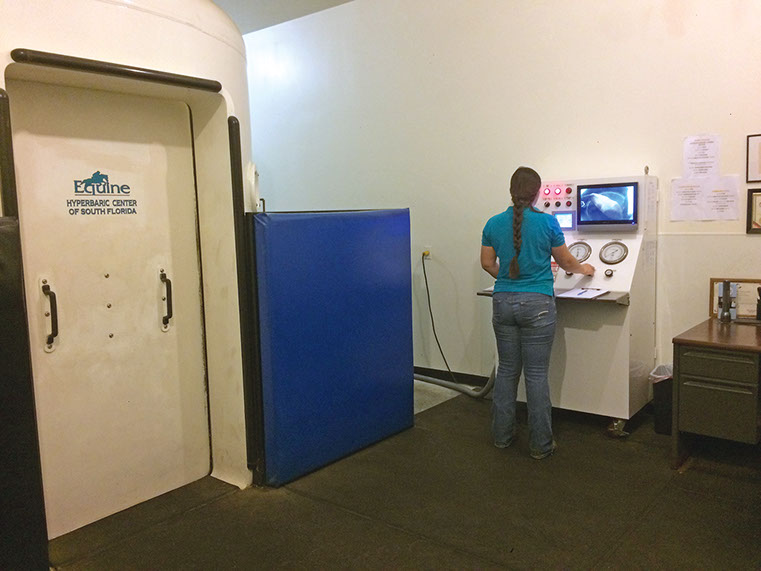

Understanding how HBOT works requires a short physics lesson. Normal atmospheric pressure exerts approximately 14.7 pounds per square inch (psi), or 760 millimeters of mercury (mmHg), on our skin and on the air that we breathe. This atmospheric air is approximately 79% nitrogen and 21% oxygen, resulting in an oxygen pressure of about 160 mmHg.
Dalton’s law states that the component gas exerts a pressure equivalent to its percentage in the composition of the mixture. HBOT is explained in terms of atmospheres absolute (ATA). Normal atmospheric pressure is equal to 1 ATA.
Normal oxygen delivery in your horse’s body is dependent on:
The hemoglobin molecule is the primary carrier of oxygen to tissues under normal atmospheric conditions. Hemoglobin is saturated with approximately 97% oxygen. A smaller amount of oxygen is dissolved in the plasma. The amount of oxygen dissolved in the plasma is referred to as partial pressure of oxygen (pO2).
Increasing the inspired oxygen cannot improve delivery by hemoglobin. Breathing 100% oxygen at normal atmospheric pressure will only increase the amount of oxygen dissolved in the plasma by a small amount.
The atmosphere and the mitochondria in the cells create a complex oxygen transport system that loses pO2 in transit. This succession of diminishing pO2 is called the oxygen cascade. The oxygen cascade creates a successive decrease in the partial pressure of oxygen as blood flow leaves the lungs and progresses to the cellular level. Capillary pO2 is less than 50 mmHg. This is reduced further at the intracellular level.
Breathing normal air (21% oxygen or 160 mmHg per ATA) at 1 ATA (sea level) would result in a pO2 of 320 mmHg. Breathing 100% oxygen in the hyperbaric oxygen chamber at 2 ATA would result in a pO2 of 1,520 mmHg of oxygen (2 x 760 mmHg); similarly using HBOT at 3 ATA would result in a pO2 of 2,280 mmHg! Therein lies the essence of hyperbaric oxygen therapy– the ability to dramatically increase the inspired oxygen, and thus the amount of dissolved oxygen in the plasma. Most therapeutic applications of HBOT involve 3 ATA or less.

The Equine Hyperbaric Center of South Florida is just minutes from Wellington, and an easy drive from equestrian showgrounds and equine training tracks and farms throughout the state.
© 2024 All rights reserved. No part of this website may be distributed in any way without permission from The Equine Hyperbaric Center of South Florida